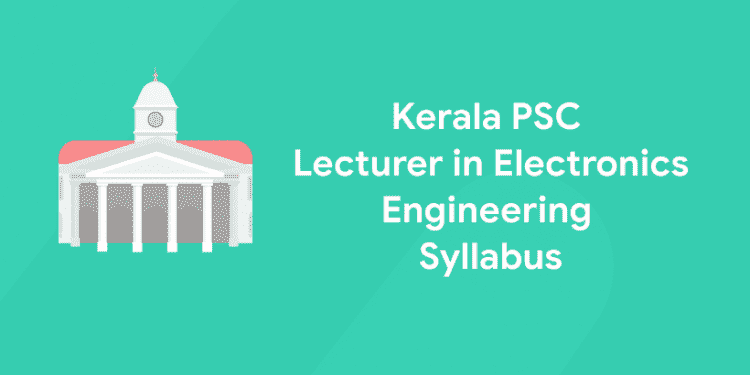Table of Contents
Kerala Public Service commission will conduct an examination to recruit candidates to the post of Lecturer in Electronics Engineering in Polytechnic Colleges. As per the latest information in the official web portal of Kerala PSC, the examination is most likely to be conducted on 5th January 2021. Further the admit card for the same will be available from 21st December 2020 onwards. However, the mode of examination is not yet confirmed. So, all the applicants who have successfully applied for the post stay tuned for further notification from the official website. Now, it is high time that we start preparing for the examination. Therefore, let us now check out the complete Kerala PSC Lecturer in Electronics Engineering Syllabus!
Practice Latest Mock Tests to ace your preparations!
Kerala PSC Lecturer in Electronics Engineering Syllabus 2020
Kerala PSC is recruiting lecturers in Electronics Engineering for the Government Polytechnic Colleges (Cat No. 019/2019). As the first step of exam preparation, it is important to be well aware of the entire syllabus of the examination. The whole Kerala PSC Lecturer in Electronics Engineering Syllabus is divided into in to modules. Let us check it out here!
| Module I | Module II |
| Technical Mathematics | Electronic Circuits |
| Basic Civil Engineering | Linear Integrated Circuits & Wave Shaping Circuits |
| Basic Mechanical Engineering | Digital Electronics, Microprocessors & micro controllers |
| Basic Electrical Engineering | Communication Engineering |
| Essentials of Electronics Engineering | Power Electronic, Opto Electronic, PLC and Measuring Equipments |
Further, let us have an insight on these two modules.
Module I
- Technical Mathematics: Matrices, Determinants, Binomial Series, Trigonometric Functions, Coordinate Geometry, Differentiation, Integration, Applications of Integration.
- Basic Civil Engineering: Materials, Construction, Surveying and Levelling.
- Basic Mechanical Engineering: The importance of IC Engines, The importance of Power Plants.
- Basic Electrical Engineering: Idea of Basic electrical circuit, Circuit parameters, Electrical circuit of an installation.
- Essentials of Electronics Engineering: Active and passive devices, Switches, Microcontrollers, Mobile technology, Inverter & UPS, E-waste: Health hazards of e-waste.
Module II
1. Electronic Circuits:
Solid state devices, Biasing methods of Transistor, Comparison of FET and BJT, Characteristics of PN junction and Zener diode, Tunnel diode, NPN and PNP transistor
2.Linear Integrated Circuits & Wave Shaping Circuits:
Differential amplifiers, Non-linear Op-Amp circuits, Log, Anti Log amplifiers, Active filters, Universal filters, Triangular wave generator, saw tooth generator, Oscillator, Integrator and differentiator using passive devices, op-amps
3.Digital Electronics, Microprocessors & Micro controllers:
- Digital Electronics: Number system, Error detection and correction codes, Shift register, Flip flops – RS, JK, T, D, edge and level trigger flip flops, excitation tables, counter – synchronous and asynchronous, up down – design, Analysis of sequential networks, derivation of state graphs and tables.
- Shift register – SISO, SIPO, PIPO, PISO, universal shift register, timing diagram, Johnson and Ring counter.
- Memory – RAM, ROM, FLAASH, NVRAM, EPROM, EEPROM, EDORAM, Memory organization.
- Logic families – fundamentals of RTL, ECL, DTL, IIL and TTL transfer characteristics Fan in and Fan out, propagation delay, Schottkey and other TTL gates, CMOS inverter, ADC and DAC – R – 2R ladder binary weighted, accuracy, resolution, conversion speed, offset error, ADC sample and hold, error of ADC, flash converter, successive approximation and dual slope.
- Microprocessors – 8086 architecture, addressing modes, instruction set, programs, Interrupts, maximum and minimum modes, interfacing chips – 8255, 8359, 8251, 8279, 8254, 8257. Basics of 80286 and 80386 – 8051
- Micro controller – architecture, interrupt, instruction set, programs.
4. Communication Engineering:
- Classification of signals, elementary signal, LTI system, Noises, Different types of Noises, Signal to noise ratio, Shannon theorem, entropy, baud rate, maximum channel capacity.
- Electromagnetic radiation and wave propagation – ground, sky, space waves, polarization, atmospheric layers and its characteristics.
- Amplitude modulation – Analysis, generation and detection of AM signals, DSB, SSB, VSB. AM transmitter – TRF and Super hetrodyne receiver, noise analysis of AM receiver.
- Frequency modulation – narrow band and wide band FM, generation of FM signals, direct and indirect methods, FM demodulation techniques, Noise in FM receiver, pre emphasis and de-emphasis.
- Phase modulation – basics of phase modulation.
- DSP – Discrete Fourier transforms – properties of DFS, decimation in time, frequency algorithm, FFT algorithm for a composite number, Signal Flow graph, digital filter design, antennas, half wave, folded dipole, microwave antenna, rhombic, parabolic, Yagi-Uda, horn, helical antenna. Television transmission – interlaced scanning, composite video signals, audio modulation, working principles of picture tubes.
- Television Camera – different types – working principle – CCD camera. NTSC and PAL colour system, Basic idea TV transmitter and receiver, PAL and NTSC decoder, basic ideas on digital TV, HD TV and satellite TV receiver.
- Basic of optical and satellite communication. Digital Modulation.
- Multiplexing Techniques.
5. Power Electronic, Opto – Electronic, PLC and Measuring Equipment:
- Thyristors – different types – SCR, UJT, TRIAC, DIAC, SCS, IGBT – working principle and characteristics. Triggering and commutation schemes – different types.
- Converters – series and parallel, Inverters – single phase and three phase, choppers, cycloconverter. Different types of industrial heating, electronic wielding, industrial applications of ultrasonic, SMPS, servo controlled voltage stabilizer, 3 pin IC regulators.
- Basics of PLCs, characteristics of LDRs, photo diode, photo transistor, photo voltaic cell, photo detector, LED, opto coupler, and laser diodes and optical amplifiers.
- Multimeter – working principle, characteristics, accuracy, sensitivity, selectivity, resolution, Construction of CRTs working principle of DSO and spectrum analyser. Working principle of LED, LCD plasma displays, logic probes, and logic analysers.
Important Note: In spite of having a defined curriculum, questions from other topics prescribed for the educational qualification of the post may also appear in the question paper. There is no undertaking that all the topics above may be covered in the question paper.
Get The Latest Updates regarding Kerala PSC Examinations 2020
Kerala PSC Lecturer in Electronics Engineering Syllabus PDF Download
1: Which Year First Assembly Election was held in Kerala?
We hope that this article was helpful to you. Entri wishes you all the best for the upcoming examinations. Stay tuned to Entri for the latest updates and notifications. We will provide you with the latest notification on all major competitive exams. Make your learning experience a happy and memorable one with us. With Entri by your side your dream job will now be a reality!











